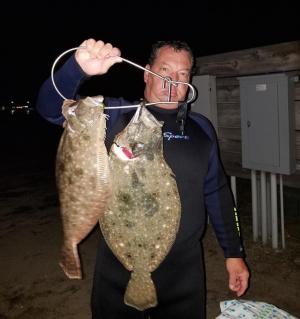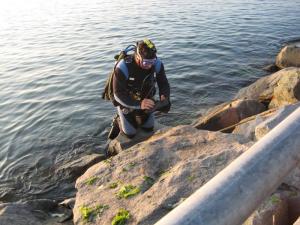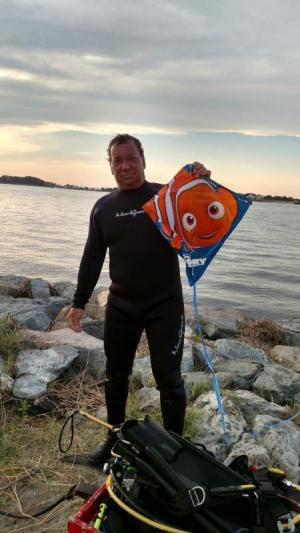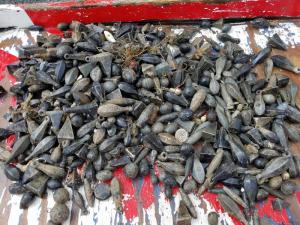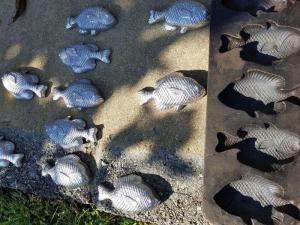Ronald Newswanger: Diving the depths at Indian River Inlet
Ronald Newswanger has gone to the deep, dark places most people try to avoid.
For 25 years, he has donned wetsuit and scuba gear to plunge into the dangerous currents where Indian River Bay meets the Atlantic Ocean.
“About 90 percent of my dives are done in the middle of the night,” he said. “Less traffic and less people fishing, so I have less chance of being hooked. People get real surprised when they try to reel me in!”
While Indian River Inlet is known for harsh weather conditions and swift tidal currents, Ronald said his early-morning dives at high slack tide are very peaceful.
“I’m as comfortable down there as someone sitting on their couch watching TV,” he said. “Though I’ve had times when I’m holding on and climbing the rocks for dear life.”
He and wife Lindy of Brickerville, Pa., have vacationed at Delaware Seashore State Park campground for about 30 years, coming down every few weeks to camp in a spot where they have made many friends.
Newswanger said initially, he and his family would anchor up at the sandbar on a friend’s pontoon boat to fish, snorkel and look for shells. Then, the friend called to say he bought scuba gear at a yard sale.
“I told him you have to be certified to dive,” Newswanger said. So, they signed up for lessons. “That’s how it all started.”
As a kid, Newswanger was fascinated by TV shows “Flipper” and “Voyage to the Bottom of the Sea.” He scoured the Sears catalog, captivated by dive gear, spears and compression tanks.
Newswanger’s first dives were to catch fish for his 55-gallon tank. Then, he began spearfishing.
“I feel more like a hunter than a fisherman,” he said.
Newswanger uses a speargun, pole spear or 5-foot aluminum pole with a rubber sling to shoot his fish. At times, visibility is only 18 inches.
Last year, during a high-visibility dive, Newswanger said, he had one of his coolest underwater experiences.
“I was diving near an old section of bridge, about 50 feet down,” he said. “I could see at least 10 to 12 feet easily, the water was very clear.”
Speargun in hand, Newswanger set out to hunt tautog when a 5-foot sand tiger shark nipped the top of his gun.
“He did a big loop, swam right over my head and was gone,” he said. “I was just sitting there watching some tog swim along a large rock. When I turned my head, I saw a faceful of teeth right in front of me!”
Newswanger said he screamed and jerked his head back.
“I think I scared him as bad as he scared me,” he laughed. “He did a 180 and was gone. After it was over, I sat down there and laughed.”
Newswanger manages to have a bit of fun below depths. His favorite story involves a flounder, a father and son.
“I was diving in the day,” he said. “I speared a flounder and put it on a kid’s fishing line. He tugged it up and didn’t believe I put it on the line. His dad said, ‘There’s a hole in it from being speared!’”
Newswanger said his scariest experience was three years ago when he was diving north of the Inlet, about 35 feet offshore.
“I had four flounder strapped to the stringer on my leg when an 8-foot bull shark came up on my left side like a gray car passing me by.”
Newswanger said the shark swam to his leg where the flounder were hanging.
“I screamed and hit him across the gills as hard as I could,” he said. “I gave him another hard push and kicked off the bottom with my feet and started swimming to the surface. That was the longest 35 feet I ever swam.”
He said he learned the inlet’s currents move in different directions at different depths when his underwater compass showed land on his right when he thought it was on his left.
“There’s a swirl down there, and the current goes in the opposite direction down deeper,” he said. “In the midpoint, the current is not as bad, but then you have to cross over stronger currents to get out.”
Newswanger loves diving at night because, with no loud boat motors droning, he can hear the fish.
“Oyster crackers sound like bullfrogs or foghorns,” he said. “Sometimes it’s really noisy with clicks and pops of different fish.”
Even in the middle of the night, though, someone is usually fishing the jetty or under the bridge.
“I’ve got to watch for fishermen,” he said. “Years ago I really scared one.”
Running low on air, he popped his head up to see exactly where he was.
“A fisherman was standing there holding his chest,” he laughed. “He told me he saw bubbles and something dark coming toward him.”
About a dozen years ago, Newswanger said, a man drove his white Mercedes off the bridge.
“Luckily, he came out through the sunroof and a boater picked him up,” he said. “The next spring, I came across the car, upside-down and half-buried in the sand. The tires were covered with mussels. Next year, there were just mussel-covered tires sticking up. The next time, it was no longer visible. The sand had completely swallowed it.”
Newswanger has seen more sharks the past couple years, near the channel in deeper water. He has even caught lobsters, which he usually finds near the Coast Guard Station.
“And when a ray rises from the bottom, it seems he takes up the whole ocean floor with him,” he said.
Mussels, however, have become scarce.
“The sad thing is, the last several years there’s no more mussels on the rocks, and they used to be covered with mussels and hundreds of starfish coming to eat them,” he said. “This year, there’s none. I’m not sure if dredging killed them off or something else. It’s affected fishing, I’m sure.”
For the past few years, he has combed the rocks under the bridge for lead weights, coming up at times with up to 50 pounds of lead.
“It’s better for the environment,” he said. “It keeps the lead away from wildlife.”
He gives many sinkers to fishermen, but needed to do something with all that lead. He got the idea to make fish molds, and bought an antique cast-iron fish-shaped hushpuppy mold at auction. He melts lead in a campsite kettle.
“It takes a while for it to melt, but only minutes for it to form in the mold,” he said.
Newswanger gives his one-of-a-kind fish molds to friends and fellow campers. He posts pictures and videos from his dives on the Indian River Bay & Inlet page on Facebook, where his exploits have attracted quite a following.
“It’s just a lot of fun,” he said. “You only live life once, so you gotta enjoy it.”














